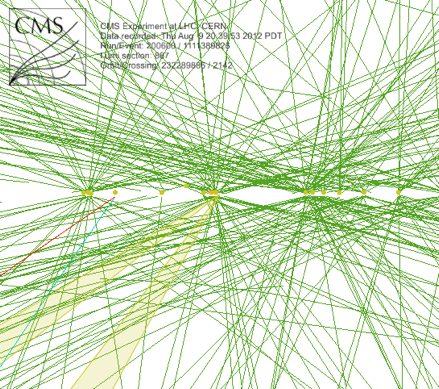Douglas Wright (15-ERD-062)
Abstract
The discovery of the Higgs boson—an elementary particle theorized to be the building block of the universe—at the Large Hadron Collider near Geneva, Switzerland, has raised more compelling questions than it has answered. These questions involve new physics, and without answers, the current particle physics theories suffer from major problems. One of these novel questions involves boson production by proton collisions. The viability of detecting colliding protons involved in boson production at the Large Hadron Collider to observe this new physics will depend heavily on the ability to reject background from event pileup—that is, the case where multiple events occur within the same beam-bunch crossing. The Compact Muon Solenoid experiment at the collider will receive an innovative proton-tagging detector upgrade that will enable an entirely new means of rejecting background in collisions. We plan to apply our expertise in picosecond timing technology to commission and calibrate the timing system of the new detectors, and then apply the high-precision timing information to a new type of analysis of W boson pairs (subatomic particles with a positive and negative charge that are each other's antiparticle). This unique production channel of W boson pairs is intimately connected with the Higgs mechanism and is important to a broad range of new physics models.
We expect to gain significant understanding of extremely fast timing in a new and innovative particle physics detector under the challenging beam conditions of an energy-frontier collider. We will lead the physics analysis that takes advantage of a new detector system at the Large Hadron Collider to extract evidence for the existence of new particles beyond the Standard Model of particle physics. This will be the first time such an experimental approach can reach the necessary sensitivity to detect new particles relevant to solving the problems of current particle theory. We will conduct the gross and fine calibration of the timing system using real data events, which constitutes full-fledged analysis of the Compact Muon Solenoid detectors.
Mission Relevance
Our search for new particles beyond the Standard Model is well aligned with a basic Laboratory core competency in nuclear, chemical, and isotopic science and technology relevant to nuclear theory and application of nuclear physics and radiochemical models to the study of fission and nuclear reactions.
FY15 Accomplishments and Results
In FY15 we (1) led a new analysis of previously unpublished data collected in 2012 for central exclusive production of W boson pairs, extending the reach for new physics searches; (2) developed, to use this substantial data set, a new technique to determine selection efficiency, which is essential for suppressing increased backgrounds observed at higher energy—we used a subset of the data itself, which is far superior to previous techniques that relied on simulations alone; (3) led the development of a precision timing system for a detector upgrade that will allow our analysis to continue when the Large Hadron Collider achieves its full design energy and luminosity; (4) modified the timing system concept to use a single-phase comparison, which reduces the hardware required by a factor of two; (5) developed and tested the scheme for converting the radio-frequency signal to a digital format required by the time measurement system used in the upgrade; and (6) verified, using a bench-top prototype, that the new system concepts maintain picosecond timing stability, which is well within the requirements needed for the upgrade.
A proton collision event from our analysis that provides evidence for the rare process of the generation of a W boson pair from a gamma–gamma particle collision. The isolated red and blue tracks are identified as a muon and electron. An excess of these types of events would indicate the existence of new particles beyond the Standard Model of particle physics.






